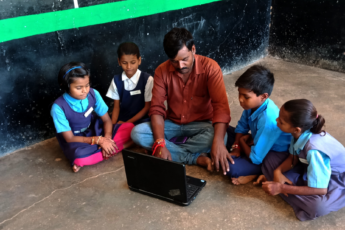The Growing Importance of Robotics in School Education

Technology advancements have led to new approaches to teaching, learning, and communicating. And robotics has become a powerful educational tool and an engaging way to explore Science, Technology, Engineering, and Mathematics (STEM) topics. The current level of sophistication and accessibility of these resources, as well as their ability to motivate students of different ages and ability levels, is undeniable.
Some schools have already begun to do this. They’ve realized that incorporating robotics into the classroom helps students understand complex concepts through hands-on experience, which is more effective than just reading about it in a book or listening to lectures. For instance, the UT Education Department has planned to set up a robotics laboratory in 14 government schools in Chandigarh, to enhance cognitive faculty and promote hands-on learning in students. The lab will have DIY robotic kits for students to learn technology and programming concepts.
In another case, the Mira-Bhayandar Municipal Corporation has set up a robotics laboratory at one of the Marathi-medium schools under a World Bank-funded project to improve teaching and learning.
Merits of Robotics in Education
Robotics is making waves in the educational sphere, and offers a plethora of benefits to students. With industry leaders touting robotics as the future of manufacturing, all signs point to why schools should strive towards infusing robotics into classroom lessons.
🤖 Preparation for Future Career Opportunities
Robotic technologies can provide an effective platform to help students develop the necessary skills for future career paths. Students who are educated in robotics may better understand how technology is changing our world. Currently, by the time students prepare to enter the workforce, they’re already playing catch-up, because the knowledge they learned in school doesn’t match up with what they’ll need. Robotics helps fill that gap by allowing students to take control of and practice operating machines that simulate real-world situations. Instructional tools such as computer-assisted instruction and online courses can be used to enhance classroom learning in the areas of programming, mechanical engineering, and applied sciences.
🤖 Simplifying Complex Programming
It isn’t easy to learn how to program a computer. Programming requires an understanding of the logical structure and how input is processed into language and action, leading to results. Robotics can make programming easier to learn and more appealing to kids who are otherwise intimidated by the idea.
Robots help children learn by creating an immediate connection between the step-by-step instructions they’re writing down (the programming), and the result of those instructions (the robot doing fun things). Instead of having to take a leap from programming instructions to see their results on a computer screen, children can create robots that immediately show them how their code works as they write it. This helps kids understand that there are actual steps involved in making something happen on a computer—they’re not just playing around with buttons on a screen or typing in random words like they might do when playing a computer game.
If you have an early learner eager to try programming but overwhelmed by its seemingly abstract concepts, robots can be a great way to make it more concrete and accessible for them to learn.
🤖 Supporting Disabled Students
Students with special needs struggle to learn the same way as others and often have trouble with social interaction and expressing their thoughts and emotions. But with robots, these students can receive a personalized experience that meets their individual needs.
Robots can be programmed to give students the support they need—they can read textbooks aloud or answer questions. Some students have sensory processing issues that make it challenging to remain focused on a lesson for the full 60 minutes of class time. Robots could provide the visual and auditory information they need without requiring them to sit still or listen intently for an extended period.
🤖 Stimulates Collaboration and Teamwork
Robotics is an innovative and engaging way to get kids excited about STEM. It gives them a chance to work together in teams, challenge each other, and fail together. By working together on problems, students can teach each other skills and develop their capacity to work as part of a team. This is especially helpful for students struggling with social issues, as it encourages them to cooperate, communicate, and interact with their peers.
In addition, it allows students to collaborate on projects, fostering creativity and imagination. This can be an excellent way for students to build their confidence because they will know that their successes are due to the contributions of others and not just their own work. In addition, robotics pushes the limits of what these students can achieve if they are willing to put in just a little extra effort.
Square Panda’s tech-driven interventions help children from all walks of life be better prepared for future challenges. To know more, visit ecce.squarepanda.in




Leave a Comment